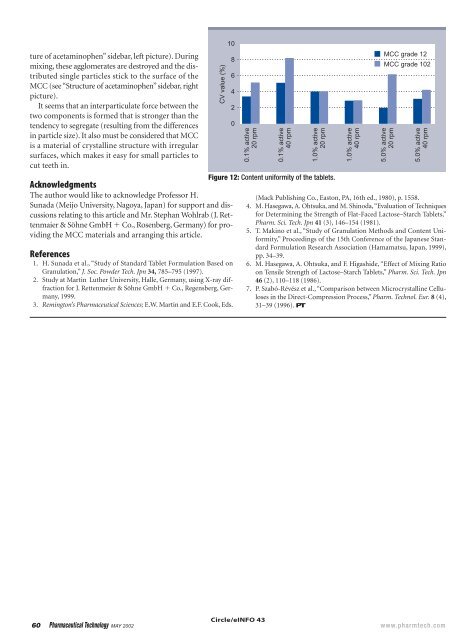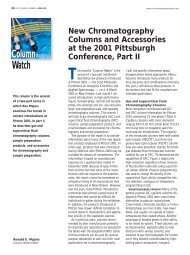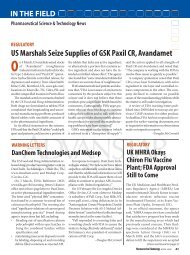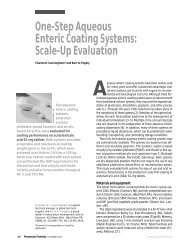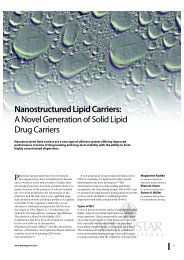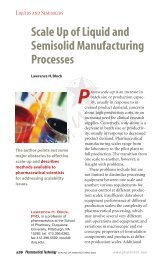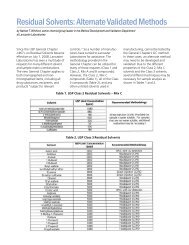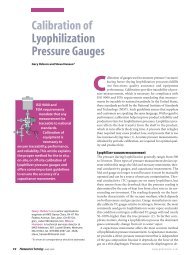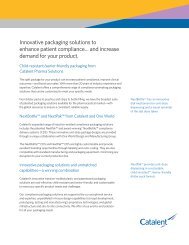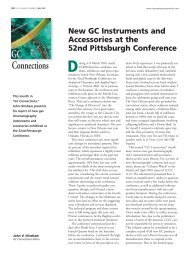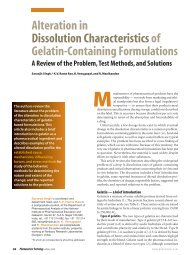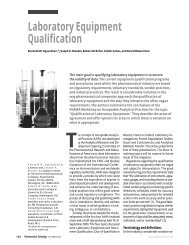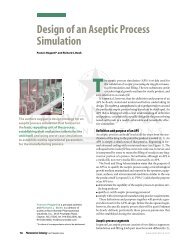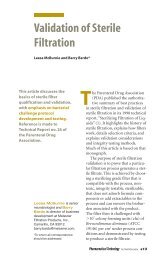Microcrystalline Cellulose Grade 12 versus Classic Grade 102
Microcrystalline Cellulose Grade 12 versus Classic Grade 102
Microcrystalline Cellulose Grade 12 versus Classic Grade 102
You also want an ePaper? Increase the reach of your titles
YUMPU automatically turns print PDFs into web optimized ePapers that Google loves.
ture of acetaminophen” sidebar, left picture). During<br />
mixing, these agglomerates are destroyed and the distributed<br />
single particles stick to the surface of the<br />
MCC (see “Structure of acetaminophen” sidebar, right<br />
picture).<br />
It seems that an interparticulate force between the<br />
two components is formed that is stronger than the<br />
tendency to segregate (resulting from the differences<br />
in particle size). It also must be considered that MCC<br />
is a material of crystalline structure with irregular<br />
surfaces, which makes it easy for small particles to<br />
cut teeth in.<br />
Acknowledgments<br />
The author would like to acknowledge Professor H.<br />
Sunada (Meijo University, Nagoya, Japan) for support and discussions<br />
relating to this article and Mr. Stephan Wohlrab (J. Rettenmaier<br />
& Söhne GmbH Co., Rosenberg, Germany) for providing<br />
the MCC materials and arranging this article.<br />
References<br />
1. H. Sunada et al., “Study of Standard Tablet Formulation Based on<br />
Granulation,” J. Soc. Powder Tech. Jpn 34, 785–795 (1997).<br />
2. Study at Martin Luther University, Halle, Germany, using X-ray diffraction<br />
for J. Rettenmeier & Söhne GmbH Co., Regensberg, Germany,<br />
1999.<br />
3. Remington’s Pharmaceutical Sciences; E.W. Martin and E.F. Cook, Eds.<br />
CV value (%)<br />
10<br />
8<br />
6<br />
4<br />
2<br />
0<br />
0.1% active<br />
20 rpm<br />
0.1% active<br />
40 rpm<br />
1.0% active<br />
20 rpm<br />
Figure <strong>12</strong>: Content uniformity of the tablets.<br />
1.0% active<br />
40 rpm<br />
MCC grade <strong>12</strong><br />
MCC grade <strong>102</strong><br />
5.0% active<br />
20 rpm<br />
5.0% active<br />
40 rpm<br />
(Mack Publishing Co., Easton, PA, 16th ed., 1980), p. 1558.<br />
4. M. Hasegawa, A. Ohtsuka, and M. Shinoda,“Evaluation of Techniques<br />
for Determining the Strength of Flat-Faced Lactose–Starch Tablets,”<br />
Pharm. Sci. Tech. Jpn 41 (3), 146–154 (1981).<br />
5. T. Makino et al., “Study of Granulation Methods and Content Uniformity,”<br />
Proceedings of the 15th Conference of the Japanese Standard<br />
Formulation Research Association (Hamamatsu, Japan, 1999),<br />
pp. 34–39.<br />
6. M. Hasegawa, A. Ohtsuka, and F. Higashide, “Effect of Mixing Ratio<br />
on Tensile Strength of Lactose–Starch Tablets,” Pharm. Sci. Tech. Jpn<br />
46 (2), 110–118 (1986).<br />
7. P. Szabó-Révész et al., “Comparison between <strong>Microcrystalline</strong> <strong>Cellulose</strong>s<br />
in the Direct-Compression Process,” Pharm. Technol. Eur. 8 (4),<br />
31–39 (1996). PT<br />
Circle/eINFO 43<br />
60 Pharmaceutical Technology MAY 2002 www.pharmtech.com


